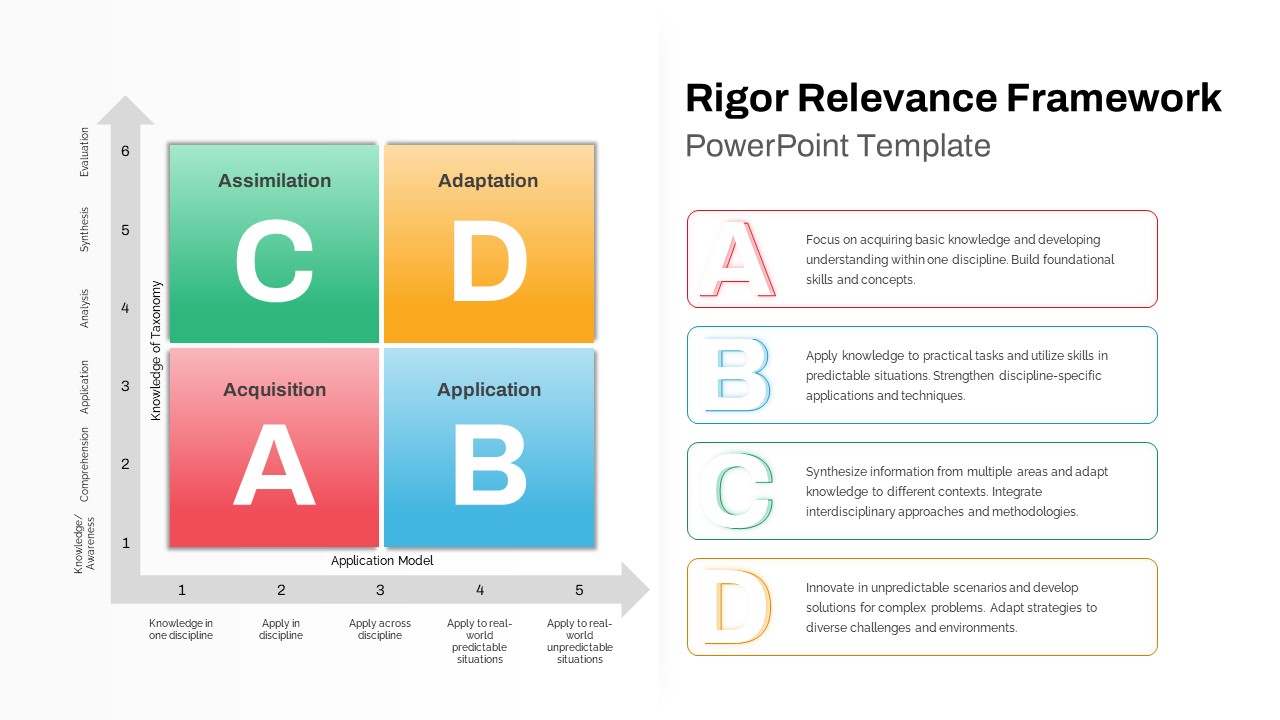Rigor Relevance Framework PowerPoint Template featured image

Description
Leverage the Rigor Relevance Framework Analysis template to visualize complex knowledge taxonomy and application domains with clarity and impact. This professionally designed slide features a 2×2 matrix with graded axes—Knowledge Taxonomy on the vertical axis and Application Model on the horizontal—divided into Acquisition (A), Application (B), Assimilation (C), and Adaptation (D) quadrants. Each quadrant is rendered in a distinct color (red, blue, green, and orange) with bold, oversized letters and custom vector icons. The clean white background, subtle drop shadows, and consistent typography deliver a modern aesthetic that aligns seamlessly with corporate branding.
The slide is fully editable with master layouts, allowing you to change color themes, adjust axis labels, and update descriptions in seconds. Drag-and-drop placeholders and grouped shapes ensure perfect alignment and maintain formatting across platforms. Whether you’re using PowerPoint or Google Slides, high-resolution graphics and vector elements preserve clarity at any scale and eliminate version control issues. Prewritten example text offers immediate context, while customizable layers enable you to tailor the framework to your specific content and audience.
Use this Rigor Relevance matrix to communicate learning outcomes, training program assessments, leadership development tracks, or strategic planning processes. Illustrate how foundational knowledge advances through real-world applications, synthesize interdisciplinary insights, or highlight innovation in unpredictable scenarios. The versatile design supports executive briefings, workshop facilitation, academic lectures, and team reviews. Seamlessly integrate the diagram with additional process flows, performance dashboards, or quadrant-based analyses such as SWOT or risk matrices, enabling you to present data-driven narratives that guide decision-making and drive stakeholder engagement.
Who is it for
Instructional designers, learning and development specialists, and corporate trainers will find this template invaluable for mapping curriculum outcomes and assessing training effectiveness. HR managers, organizational development consultants, academic lecturers, and strategy teams can also leverage it to illustrate competency frameworks, decision-making models, or innovation processes.
Other Uses
Beyond educational taxonomies, repurpose this quadrant framework to analyze market segments, prioritize product features, diagram risk assessments, or compare strategic options. It can also illustrate performance evaluation models, customer experience journeys, or maturity assessments in HR, IT, and operational excellence initiatives.
Login to download this file

















































